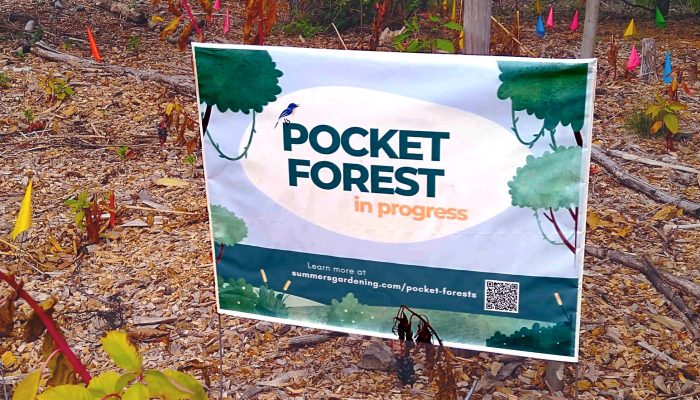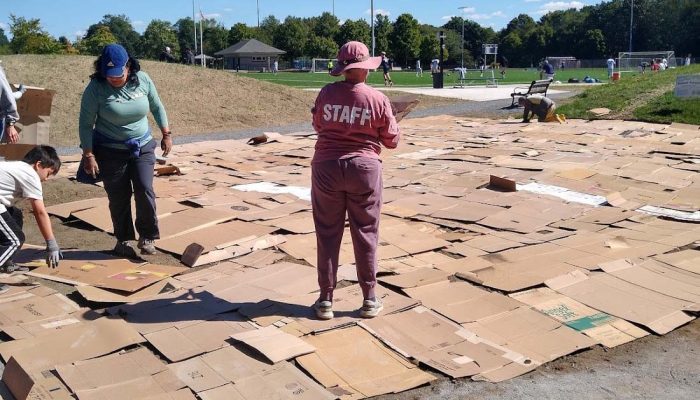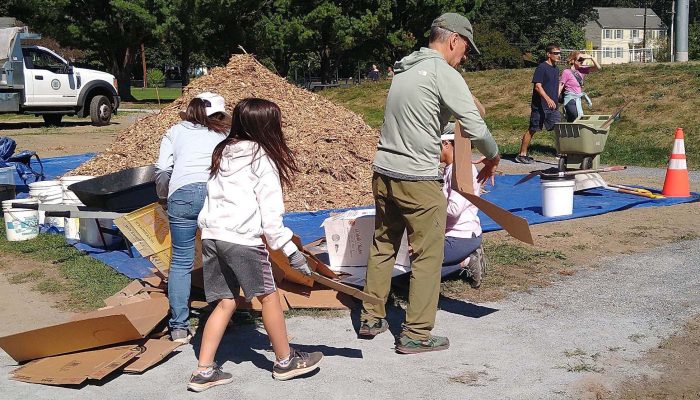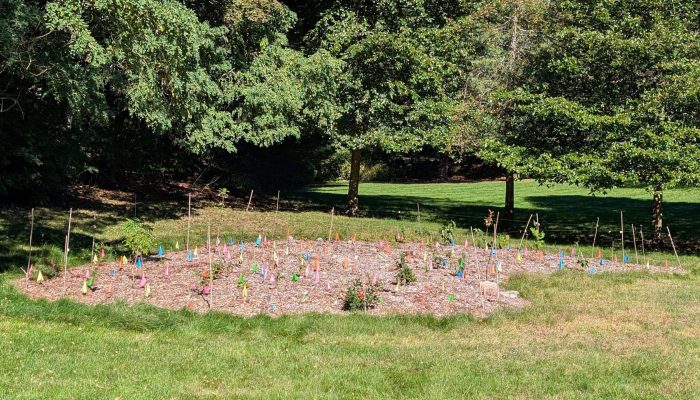Growing the Future, Plot by Plot
How pocket forests are taking root in Lexington

Project organizer, local gardener and Lexington Tree Committee member Rachel Summers explained that the Lincoln Fields site is the first pilot project on town land to test an innovative planting concept called a “pocket forest.”
Also known as tiny, micro or mini-forests, pocket forests are small, dense groves of closely planted diverse native tree and shrubs. They mimic natural forest structure with canopy trees, understory, and shrubs, all growing together, and they can grow up to ten times faster than individually planted trees and become self-sustaining in 2–3 years, said Summers.
The Lexington project is part of a global surge of interest in mini-forests, driven by their potential to capture stormwater, carbon and pollution, and provide habitats for native birds, bees and butterflies at a scale accessible to neighborhood organizations, schools, clubs, corporations and families.
As a board member of the Lexington Field & Garden Club and Lexington Climate Action Network (LexCAN), an organizer at Lexington Interfaith Garden, and a member of the Town of Lexington Tree Committee, Summers is embedded in the town’s complex ecosystem of environmental action groups.
Through those connections she scheduled the soil-prep session to coincide with a Sun Power Celebration, hosted by the Town and LexCAN. Other attractions were solar-powered music – “Here Comes the Sun”– games and crafts, coaches on hand to offer advice and information about clean energy, and a Big Backyard nature walk led by environmentalist and former K-5 Science Coordinator for Lexington Public Schools Fran Ludwig.
Japanese Inspiration
Several volunteers at Lincoln Fields knew about the work of pioneering Japanese biologist and ecologist Dr. Akira Miyawaki (1928-2021), the grandfather of the mini-forest movement. His approach, developed in the 1970s, was shaped by observation of the dense, resilient, and healthy thickets of native trees around Japan’s historic temples and shrines.
From Japan, which now has thousands of Miyawaki forests, the movement has spread across Europe, Africa, Asia, South America, and the Middle East. Summers has mapped and listed over 70 pocket-forests created in the U.S. since 2021, including a cluster around Boston, in Cambridge, Brookline, Watertown Winchester, and Somerville.
Lexington Tree Committee member Nancy Sofen was peeling non-biodegradable labels and tape from cardboard boxes before they could be used as groundcover. She remembered reading about Miyawaki forests when the City of Cambridge planted one of the first in the Northeast U.S. in Danehy Park in fall, 2021.
One of the largest Miyawaki forests in the world is in his home state of Gujurat, India, where it serves as a memorial to victims of the 2001 earthquake there, said retired asset manager and Lexington Interfaith Garden volunteer gardener Sandeep Patel.
Long-time climate activist Ricki Pappo, Chair of LexCAN, said the group had discussed the idea of incorporating a mini-forest into the new Lexington High School campus, but that projected costs were seen as a barrier. “I’m so excited the town got involved and is encouraging this,” she said. “It’s so great for people to learn from.”
Lawn to Foodscape: Work in Progress
A couple of weeks before the Lincoln Fields prep day, Rachel Summers showed a visitor round her luxuriantly diverse yard in Lexington. A sign from the National Wildlife Foundation out front recognizes the property as a “Certified Wildlife Habitat.” On the sidewalk Summers has set up a native seed plant library in an old three-drawer dresser, complete with laminated cards giving creative seed-starting and planting tips.
Sun-chokes, scarlet and purple runner beans intermingle with fruit and nut trees, and tall stands of cut-leaf coneflower add bursts of blazing yellow. The whole area is watered by a drip irrigation system fed by rainwater collected on the house roof, and a pond pump keeps the water circulating. “This is a little piece of the earth,” said Summers, “and ecologically it has the potential to be just as important as space set aside for conservation.”
A self-described “plant nerd,” as a pre-schooler Summers set out to memorize the Audubon Field Guide to native plants. When she started her gardening company, Summers Gardening, in 2024, she combined this lifelong love of plants with over a decade of experience in strategic problem-solving in design and operations management, an approach that she now applies to planting, “balancing creativity, logistics, and long-term thinking.”
Summers started experimenting in earnest on her own property during the COVID-19 pandemic. She embarked on a long-term “lawn-to-foodscape” conversion, in tandem with a major home renovation, pulling out invasive plants and buying replacement native saplings online. The “Joe Gardener” podcasts by Joe Lamp’l, creator and host of the Emmy award winning PBS TV series “Growing a Greener World,” were a major source of inspiration and information.
In one episode, Lamp’l interviewed Basil Camu, owner of Leaf & Limb, a tree service and ecological advocacy company in Raleigh, NC, and author of From Wasteland to Wonder: Easy Ways We Can Care for Trees and Help Heal Earth in the Sub/Urban Landscape. Camu’s method for planting pocket forests “described exactly what I’d been doing,” said Summers.
Camu and Summers favor a simplified, low-cost variant of the classic Miyawaki method, skipping the need for heavy digging equipment and intensive – and expensive – soil enrichment and preparation. “What I’m trying to pilot here is a process that any homeowner can use in their yard,” said Summers.
The method involves covering the site – at least 100 square feet – with cardboard and a thick mulch of arborists’ wood chips to block weeds and retain water, leaving for a couple of months, then planting with a dense mix of native saplings, around 25 per 100 square feet.
The Lexington Town Tree Committee works with the DPW and the Tree Warden to advocate for tree preservation and planting, draft tree-friendly regulations and bylaws, plant street trees, and develop an Urban Forest Master Plan. Since joining in April 2024, said Summers, she has advocated for the inclusion of less expensive and labor-intensive approaches to tree-planting, including more use of saplings and the pocket forest model. At the committee’s November 2024 meeting, attended by DPW manager Dave Pinsonnault, he agreed to consider a pilot on town land. Within four hours of the meeting Summers had sent him a draft operational plan.
R & D in the Field
While waiting for a municipal site to be identified and approved, Summers looked for other spaces to test the flexibility of her concept. She currently has seven pilot projects on private property in Lexington and one in Bedford. Each is unique, she said, and each presents its own challenges and learning opportunities.
“I’m excited about this!” said LexCAN Chair and longtime climate change activist Ricki Pappo, pointing out a bowl-shaped depression covered with Virginia creeper in her Lexington back yard, beyond the thriving vegetable and pollinator gardens. The hollow has always been there, and she speculated that it was left by a long-dead tree. It is now filled with a rich mulch of years’ worth of fallen leaves, punctuated by brightly colored landscaper’s flags showing where Summers has planted around one hundred tiny trees. For this project, said Pappo, Summers did not use cardboard, and she left some of the creeper as ground cover. “I love the concept [of pocket forests]” said Pappo. And now she hopes to see the proof of concept in her own backyard.
“This house was blasted out of granite – the soil is terrible!” said tax analyst Julie Sibert, showing a visitor around the almost-two-acre lot surrounding the 1980s house where she has lived since 1991. For years, she has battled encroaching invasive species, particularly the notoriously resilient Ailanthus altissima, also known as Tree-of-heaven. A decade of ruthless cutting back failed to halt its spread, and Sibert reluctantly resorted to poisoning the clear-cut stumps.
A meeting with Summers led to a new approach. “Rachel said, let’s try a pocket forest,” Sibert recalled. “I didn’t want to put poison in the ground forever,” she said, attracted to the idea that a densely planted grove of native plants, once established, would deny space to invasive species.
After prepping the L-shaped plot in February 2025 with clean cardboard and four truckloads of fresh woodchips, Summers planted 600 saplings and tiny plants marked by color-coded landscaping flags, and created narrow pathways bordered by old sticks. “You have to be very persistent,” said Sibert, “but Rachel is doing great things,” regularly monitoring progress and removing invasive interlopers.
“Pocket Forest in progress,” reads a sign at the road-facing edge of the property, with a QR code linked to Summers’ website. “The neighbors are totally on board – they’re very interested to know what’s going on,” said Sibert. She accepts that the project is experimental and results unpredictable, but she sees her little forest as one small step towards protecting the environment. “I can’t fix the whole town,” she said, “but I can try to fix my own property.”
As no Lexington gardener will be surprised to learn, rabbits and deer devoured some of the hundreds of seedlings Summers planted in April 2025 in a kidney-shaped plot behind the house of writer and community volunteer Jeri Zeder and Select Board member Joe Pato. A chance meeting at a LexCAN social event in December 2024 led to the invitation to use part of their extensive lawn as a pocket forest pilot site.
“Rachel’s looking at this as an experiment, and we haven’t interfered,” said Zeder, who makes no claims to be a gardener. In June Summers ringed the plot with a single fishing line about three feet high, held up with bamboo stakes, to deter deer. Always conscious of the fact that ecologically speaking, lawns are a waste of space, Pato has tried previously to establish small, fenced areas of pollinator plants. Because of its scale and diversity, “this is a much more interesting experiment,” he said.
In June, the Pato/Zeder pilot project was one of the gardens open to the public on the annual tour organized by Lexington Living Landscapes, a volunteer nonprofit that fosters sustainable landscaping practices on public and private land.
“Rachel’s done a terrific job of spreading the word about pocket forests” said the group’s steering committee chair Charlie Wyman. “Pocket forests have great potential, and we’re learning more about their benefits all the time,” he said. “They’re not a panacea,” he cautioned, “but they are an important option – one among many – for restoring the ecological health of our towns. I can’t wait to see how they grow and thrive!”
For more information: https://www.lexingtonma.gov/2430/Lincoln-Park-Pocket-Forest
For a list of local groups working on environmental issues in Lexington, see: grassrootsfund.org/groups/lexington-green-network





